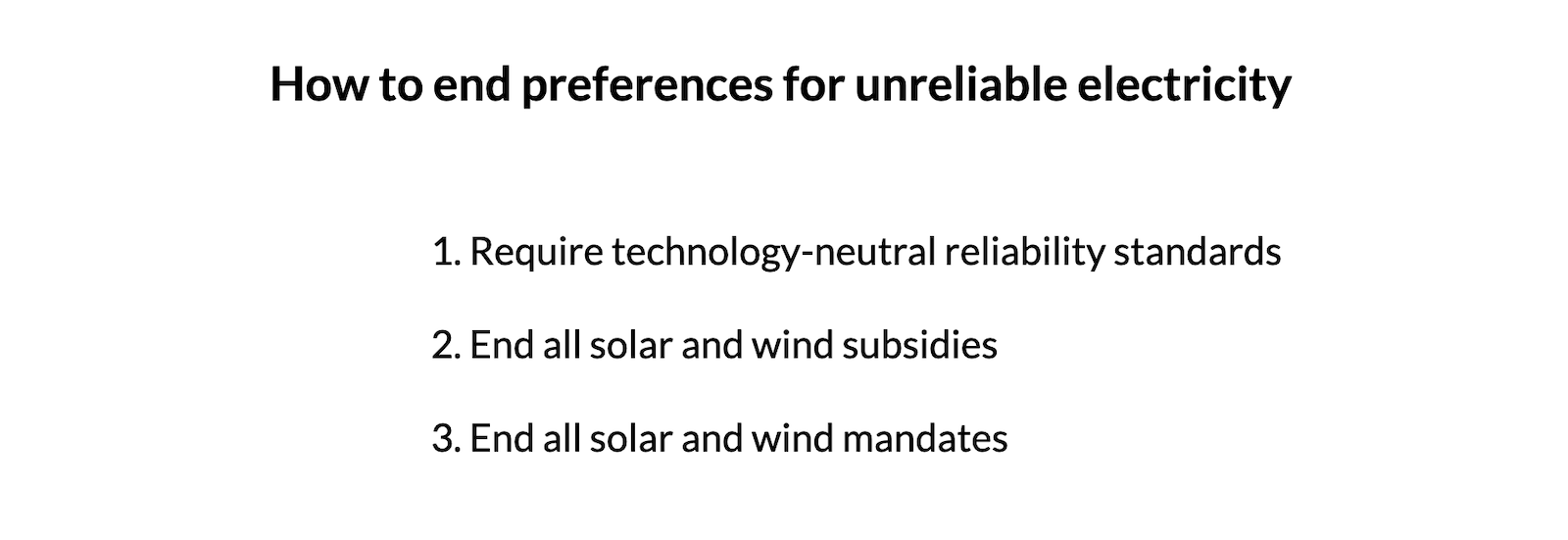Originally published on December 14, 2022
Today's grids are being ruined by systemic preferences for unreliable electricity:
1) no price penalty for being unreliable
2) huge subsidies for unreliables
3) mandates for unreliables
Congress should end these now.

-
The Opportunity
America, given its combination of abundant domestic energy resources, technological ingenuity, and free-market competition, has the potential to have the best grid in the world—providing electricity that is low-cost, ultra-reliable, and increasingly clean.
-
The Problem
Although America could have world-leading electricity, the American grid is instead becoming a national embarrassment—with rising costs and mounting reliability problems, most problematically in California and Texas but now spreading around the country.1
-
The cause
A root cause of America’s cost and reliability problems is extreme preferences for unreliable solar and wind electricity:
- no price penalty for being unreliable
- huge subsidies for unreliables
- mandates for unreliables
Here’s how they work and how to fix them.
-
Unreliability preference 1: no price penalty for being unreliable
In almost every area of life we pay far more for a reliable service than for an unreliable one. But in electricity, unfair rules make utilities pay the same for unreliable solar and wind as they do for reliables.
-
Policy solution: Electricity markets should require all generators to meet technology-neutral reliability standards.
The Federal Energy Regulatory Commission (FERC) and ERCOT (the Texas regulator) should set reliability standards that all competitors must meet—not allow some to sell unreliable electricity, as they do now.
-
Technology-neutral reliability standards do not prevent solar and wind from being used.
They simply require that generators who want to use solar and wind take responsibility for combining it with reliables and/or storage to guarantee reliability. Instead of foisting responsibility on others.
-
Technology-neutral reliability standards may well lead to innovative, truly cost-effective uses of solar and wind—e.g., solar/gas/battery hybrid generators in sunny parts of the country that can provide reliable electricity at lower costs.
-
Any company or academic who believes that solar and wind can be cost-effective generation sources on a large scale should welcome technology-neutral reliability standards.
They can try to prove their ideas on the market—not force us to use unreliables and then trust that it’ll work out.
-
With tech-neutral reliability standards, electricity “markets” can function as competitive markets—lowering costs and raising reliability—since all competitors will have to offer the same level of value.
Vs. today’s insanity of valuing reliability and unreliability equally.
-
Unreliability preference 2: huge subsidies for unreliables
Subsidies for unreliable electricity, above all the Investment Tax Credit and the Production Tax Credit, force taxpayers to pay huge amounts of extra money to unreliable solar and wind generators.
-
The “Investment Tax Credit” and “Production Tax Credit” solar and wind subsidies pay utilities to shut down or slow down reliable gas and coal plants whenever the sun shines or the wind blows. This defunds reliable plants, causing many to be shut down.2
-
Solar and wind subsidies are driving reliable power plants out of business, leading to higher costs and lower reliability.
Ominously, the “Inflation Reduction Act” recently extended them indefinitely.
A future Congress should end solar and wind subsidies, driving lower prices and higher reliability.3
-
The “Inflation Reduction Act” pretended to be pro-nuclear by including nuclear under “clean energy” subsidies. But since nuclear overregulation makes new plants cost-prohibitive, the IRA’s endless “clean energy” subsidies created an endless trough for solar and wind.
-
Another solar and wind subsidy of the IRA is “green hydrogen.” The IRA forces us to give those who make hydrogen using solar and wind an extra $3/kg. That’s twice the normal market price! This is like forcing taxpayers to pay gas stations an extra $8/gallon!4
-
Another form of subsidy to eliminate: government subsidizing unreliable solar and wind by socializing their costs, such as additional transmission lines or redundant backup capacity. This subsidy further rewards unreliable electricity at the expense of reliables and of customers.
-
Solar and wind subsidies not only drive the shutdown of reliable power plants and loot taxpayers, they also inflate electricity prices. Because solar and wind can go near-zero at any given time, they don’t replace most of the costs of reliable power plants—they add to them.
-
The combination of no price penalty for unreliability and special subsidies for unreliables means that instead of unreliables receiving far less dollars than reliables, they get a huge premium. And more and more reliable power plants go out of business.5
-
Policy solution: End all subsidies for unreliables.
Abolish the Investment Tax Credit and Production Tax Credit. Stop “green hydrogen” subsidies. Require generators using solar and wind to pay for the extra infrastructure they need instead of forcing others to foot the bill.
-
Unreliability preference 3: mandates for unreliables
Even beyond paying a premium for unreliable electricity, many states mandate a certain percentage of unreliable solar and wind—and states are becoming more and more aggressive with those mandates. Another dire threat to our grid.6
-
Policy solution: End all mandates for unreliable solar and wind
These mandates, which require areas to use solar or wind and shut down reliable fossil fuels and nuclear, regardless of the impact on cost and reliability, should be ended at every level: national, state, and local.
-
Summary: America can stop the decline of our grid and move toward low-cost, reliable, and cleaner electricity by ending all preferences for unreliable electricity:
- Require tech-neutral reliability standards
- End all solar and wind subsidies
- End all solar and wind mandates
References
-
Utility Dive - FERC commissioners respond to elevated power outage risks across two-thirds of US
Alex Epstein - The EPA vs. the grid
Alex Epstein - Electricity Emergency
Alex Epstein - Talking Points on the Texas Electricity Crisis
-
Energy.gov - Production Tax Credit and Investment Tax Credit for Wind Energy
-
“Credits are set to phase out the later of 2032 or when emission targets are achieved (i.e., the electric power sector emits 75% less carbon than 2022 levels).”
Energy.gov - Inflation Reduction Act Summary↩ -
Prices for hydrogen from natural gas are about $1.5 to $2 per kg.
Utility Dive - The Inflation Reduction Act upends hydrogen economics with opportunities, pitfalls↩
